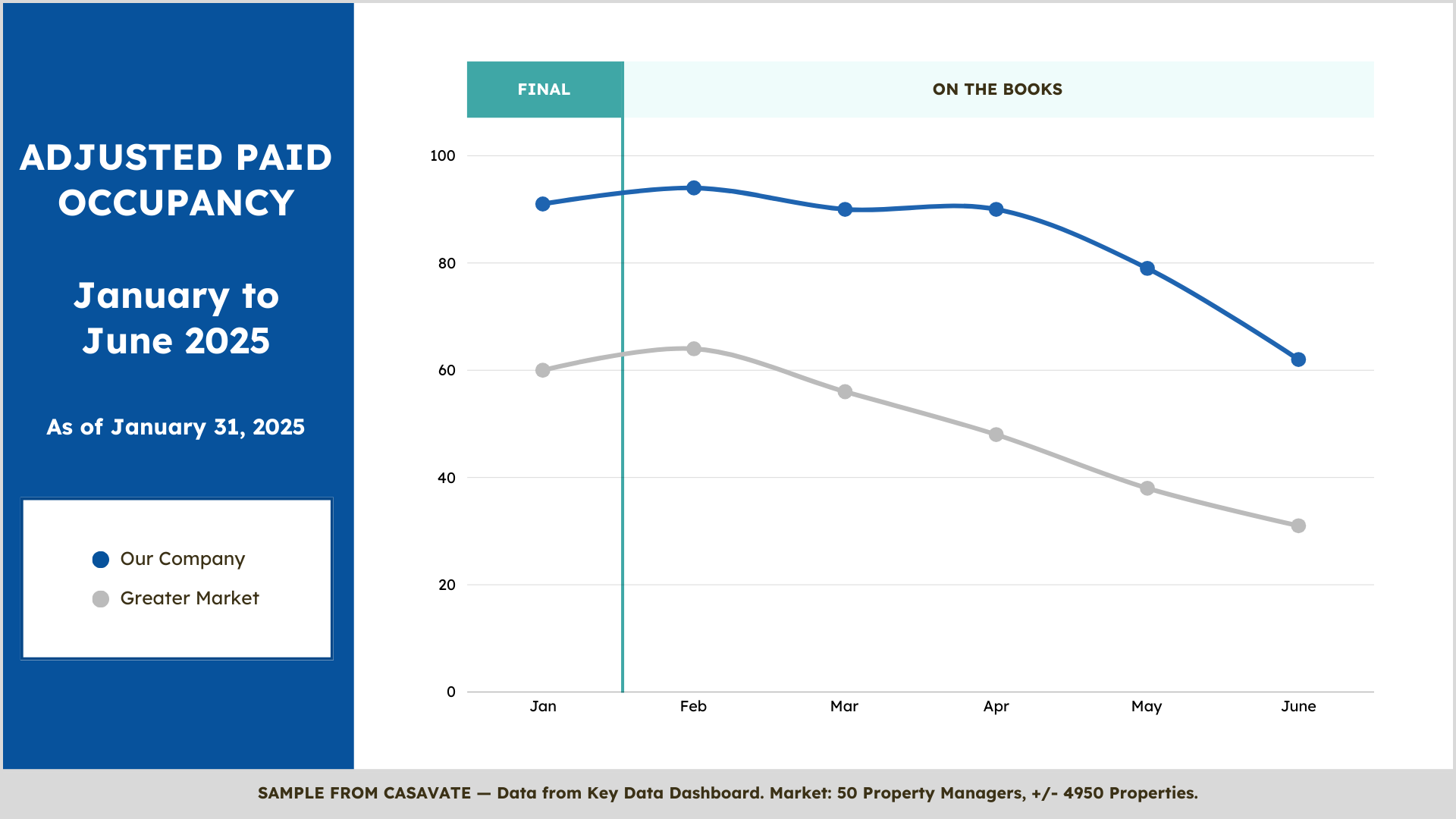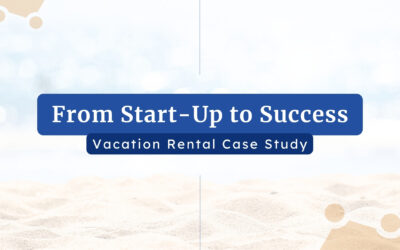As we head into 2025, the vacation rental industry is more competitive than ever. With new technologies, an ever-growing number of property managers, and shifts in traveler behavior, it’s no longer enough to follow trends — you need a solid, data-driven vacation rental marketing plan for your management company that adapts to these changes.
According to Key Data Dashboard’s 2024 December Overview, demand has remained steady while supply growth has slowed down a bit (only a 3% increase in 2024 compared to 11% in 2023). But with more properties on the market, competition is fiercer, and occupancy levels are taking a hit across the board.
The question for vacation rental property managers is clear: How do you navigate these market dynamics to maintain profitability and drive growth? This guide will walk you through our top recommendations for creating a comprehensive marketing plan that sets your company up for success in the year ahead.
Step 1: Evaluate Your Current Marketing Efforts
Before developing an effective vacation rental marketing plan, it’s essential to assess where you currently stand. An evaluation of your current resources, marketing channels, and performance metrics will help you understand what’s working and where there’s room for improvement.

Take Inventory of Current Resources
Start by reviewing the fundamental elements of your marketing strategy to ensure you’re fully prepared to succeed:
Website Optimization
Is your vacation rental website optimized to convert visitors into booking conversions? Visitors should easily find basic information like property details, availability, and booking options. If visitors can’t quickly navigate your site, they may abandon their search. Ensure it’s user-friendly, mobile-responsive, and includes clear calls to action (CTAs) for bookings throughout. When searching for properties, is it easy to add dates and filter selections? Is the checkout process straightforward and easy?
Property Distribution Strategy
Where are your properties listed? Do you have a diverse distribution strategy, or are you relying too heavily on a few platforms? In addition to listing on major OTAs like Airbnb and VRBO, consider niche platforms that cater to specific audiences such as eco-conscious, luxury, or pet-friendly travelers. These platforms may open up new streams of potential guests.
Marketing Channels
Are you utilizing the full range of marketing opportunities available to you? This includes:
- SEO: Is your website ranking well for relevant search terms?
- PPC Advertising: Are you running paid campaigns that are generating quality leads?
- Email Marketing: Are you effectively nurturing leads through targeted email campaigns?
- Social Media: Are you engaging with your audience consistently and authentically on platforms like Instagram and Facebook?
Marketing Budget
Review your current marketing spend. Are you investing your budget in the highest ROI channels? Make sure your budget aligns with your business goals and prioritize high-performing strategies. If you’re unsure which marketing efforts deliver the best results, keep reading for metric recommendations.
Team Capacity
Does your team have the bandwidth and expertise to carry out your marketing plan, or are you stretched thin? If you lack the internal resources to implement your plans, it may be worth outsourcing specific tasks or collaborating with a marketing agency that specializes in vacation rentals.

Analyze Key Metrics
Once you’ve taken inventory of your current marketing resources, it’s time to dive deeper into the data. Tracking and analyzing metrics is key to understanding whether your marketing strategy is achieving the desired results. By evaluating these key performance indicators (KPIs), you can identify areas for improvement and make data-driven decisions that maximize profitability and growth. Here are some important reports and metrics that provide valuable insights into the performance of your properties and marketing efforts:
Booking Sources: Direct vs. OTA
We recommend starting by evaluating where your bookings are coming from. Understanding your booking source mix is important for optimizing your distribution strategy. While OTAs can help with visibility, they often charge commission fees that reduce your profit margins. By analyzing the direct vs. OTA ratio, you can better assess your marketing budget allocation and focus on improving your direct booking channels.
Website Booking Sources
Digging deeper into the sources of your website bookings is also crucial. Are your guests coming from organic search, paid ads, social media, email marketing, or referral sites? By attributing bookings to specific channels, you can evaluate which marketing efforts are performing best and which need more focus or resources.
Adjusted Paid Occupancy Rates
This metric evaluates whether your properties are consistently booked during peak and off-peak seasons. Monitoring your Adjusted Paid Occupancy Rates gives you a clear picture of whether you’re utilizing your property’s potential throughout the year.
Adjusted RevPAR
If your Adjusted RevPAR is lower than expected, your pricing strategy may not be optimized, or your marketing efforts aren’t reaching the right audience. RevPAR can help identify areas where rate adjustments are necessary, or more targeted campaigns could help boost conversions.
Booking Window Trends
Are guests booking well in advance, or are you receiving a lot of last-minute reservations? Understanding lead times will help you plan promotions and pricing strategies more effectively.
Benchmarking Reports
Benchmarking is invaluable for identifying areas where you’re excelling and areas that need improvement. If your performance is significantly below market averages, it could indicate that adjustments in your strategy are needed, whether that’s through targeted promotions, optimizing your listings, or adjusting your pricing.

Identify Strengths and Weaknesses
After reviewing your performance metrics, it’s time to identify what’s working well and where there are opportunities for improvement:
Distribution
Did you find out most of your bookings come from one source? If you’re heavily reliant on a single OTA or marketing channel, you could be exposed to risk — particularly if there are algorithm or policy changes. Diversifying your marketing mix across different platforms can help mitigate that risk and open up more opportunities for bookings.
Marketing Channels
Are your marketing channels performing as expected? For example, maybe your paid ads aren’t generating the right traffic, or your social media efforts aren’t yielding engagement. Understand which areas need optimization and focus resources there.
Underperforming Properties
To go one more level deeper, did you find certain properties are underperforming? Take a closer look at potential reasons — do the listings need updating, or are they being displayed on the wrong platforms? Maybe the description isn’t engaging enough, or the photos need a refresh.
Step 2: Optimize Your Listings for Visibility
A strong listing is vital for standing out in a crowded market. Whether you’re using OTAs or your own website, you need to ensure your properties are highly visible and attractive to potential guests. Start by reviewing your property listings across all platforms for these key elements:

High-Quality Photography
Investing in professional photography is no longer optional — it’s a necessity. I remember creating a case study about eight years ago that showed a significant year-over-year improvement in bookings for a property that had updated high-quality photos added to the listing. Since then, more recent studies have consistently demonstrated that visually compelling images remain one of the most influential factors in driving conversions.
Well-lit, high-resolution images allow guests to picture themselves in your space and significantly increase the likelihood of securing a booking. Be sure your first image is particularly eye-catching; this is the one guests will see first and use to decide whether they want to explore your listing further.
Catchy & Informative Headlines
Speaking of the first things your guests will see — your headline should also be catchy yet informative! Highlight what makes your property unique or special. Rather than using a generic title like “Oceanfront Home on Beach,” go for something more enticing and specific, such as “Oceanfront Home with Private Pool & Direct Beach Access.” This immediately tells potential guests what they can expect and helps your property stand out in a sea of listings.
Compelling Descriptions
Once your first photos and headline have captured a guest’s attention, your property listing description will help seal the deal. This is where you need to sell the experience while providing essential details that will confirm your property is the right choice for their needs.
Avoid simply listing features — focus on the benefits. For example, instead of saying, “3 bedrooms, 2 bathrooms,” try, “Relax in your spacious 3-bedroom villa with two luxurious bathrooms, perfect for families or groups looking to unwind after a day at the beach.” Highlight what makes your property unique and explain why it stands out. Include bedroom configurations (king, queen, etc.), and don’t forget to mention nearby attractions or activities guests can enjoy during their stay.
Review Distribution Settings
Has anything changed since you first created your listings? It might be time to revisit and update key details, such as company information, area details, or property policies. We often find that listings don’t have every applicable amenity selected. That might seem like a small detail that would not impact your bookings — but it means that your property will not show in the search results if potential guests select that amenity as a filter when searching. For example, if your property has a private pool, hot tub, or pet-friendly policy, these features should be prominently listed and easy to find.
Price Optimization
By pricing your properties effectively, you will stay competitive while maximizing revenue. I always return to the key concept: “Your pricing is only as good as your marketing, and your marketing is only as good as your pricing.” In other words, pricing and marketing must work hand-in-hand — neither can reach its full potential without the other.
To truly optimize your pricing strategy, consider using dynamic pricing tools that adjust rates based on demand, competitor pricing, and seasonality. If you don’t have an in-house revenue manager, consulting with a professional may be worthwhile to ensure your pricing is competitive and aligned with your marketing efforts.
Step 3: Develop a Multi-Channel Digital Marketing Strategy
A successful vacation rental marketing plan requires a balanced approach. By using a variety of marketing channels, you can increase visibility and attract more bookings. Here are some of the key channels we use to drive results for our clients:

Listing Distribution
Get your property in front of as many potential guests as possible by listing it on the most relevant booking platforms. Don’t just stick to the big OTAs — expand to niche platforms where your ideal guests might be looking.
Website SEO
Your website should be working for you 24/7. Make sure your website is optimized to rank well in search engines. This means using the right keywords and creating compelling content that speaks to both search engines and your guests.
PPC Advertising
Want to attract high-quality leads right away? PPC campaigns, like Google Ads, can help you attract quality leads. Be sure to target the right audience at the right time.
Email Marketing
Stay connected with past guests and potential customers by sending personalized email campaigns. From welcome emails to special promotions, email marketing keeps your property top-of-mind and encourages repeat bookings.
Social Media
While this channel may not always lead to trackable direct bookings, social media is a great tool for building trust and engaging with potential guests. You can also connect with local communities or interest groups on Facebook to attract more guests.
Target Niche Markets
Consider emerging market segments, such as remote workers looking for long-term stays, eco-conscious travelers, or groups booking extended stays. Tailoring your marketing to these audiences can help differentiate your properties.
Leverage Technology
Look into new technologies that can help improve your marketing efforts. For example, Direct Booking Tools offers a plugin that compares your direct booking rates to those on OTAs, showing guests how much they can save by booking directly. This not only encourages direct bookings but also builds customer loyalty by providing transparency and value. Consider adding a chatbot on your website where guests can instantly reach a member of your guest services team.
Forge Local Partnerships
Building strong relationships with local businesses and organizations can enhance the guest experience and provide mutual benefits. By collaborating with local attractions, restaurants, and event organizers, you can offer your guests exclusive experiences and encourage repeat bookings. This can be as simple as printing out rack cards to leave behind at local businesses — you could go the extra mile by offering to mention their company on your website or inserting their materials into your welcome packets.
Step 4: Enhance the Guest Experience
Happy guests are repeat guests, and exceptional guest experiences lead to repeat bookings, positive reviews, and word-of-mouth referrals. A memorable stay is about more than just a clean property — it’s about creating moments that delight and make guests feel valued. By focusing on these small yet impactful touches, you’ll foster loyalty and keep your bookings steady throughout the year. Here are a few ways to enhance the guest experience:

Streamline Communication
Effective communication is a cornerstone of guest satisfaction. The more smoothly your communication flows, the more likely guests will feel at ease and engaged, leading to positive feedback and repeat bookings. We have an entire post about connecting with your guests through the 8 stages of their journey that you may find helpful as you delve into reviewing your guest communications.
The next step, audit your current processes: Do your messages have consistent branding? Are they timed to provide value at key moments? Can automation tools streamline your process?
Sample Communication Timeline:
- Upon Booking: Confirmation email
- 30 Days Before Arrival: Area information
- Week Before Arrival: Welcome email with detailed instructions
- 2 Days Before Departure: Checkout instructions
- Day of Departure: Review request
Invest in Branded Materials
Small gestures can leave a big impression. Branded materials create a memorable guest experience, foster brand recognition, and encourage repeat bookings. Think about the items that guests will actually use or appreciate long after they leave:
- Branded Welcome Bags or Boxes: Fill these with locally sourced snacks, maps, and a few thoughtful, branded items. These might include items like water bottles, sunscreen, or reusable coffee cups.
- Long-Lasting Items: If you want to really make an impact, choose items that guests can keep and use year-round. Quality beach bags, towels, or cooler bags are especially popular in beach markets. Guests will associate your property with these useful items, making them more likely to return next season.
- Small Touches: Add branded keychains, soaps, or candles to the bathroom or bedside table. These simple touches often go a long way in making guests feel cared for.
Upsell Extra Services
Offering value-added services isn’t just about increasing your revenue—it’s about adding value to your guests’ experience. These services improve the guest’s stay and make them feel cared for in ways that traditional amenities cannot.
- Early Check-Ins and Late Checkouts: Many guests appreciate a little extra flexibility, especially if they have late flights or want to squeeze in one last morning at the property. Offering early check-ins or late checkouts for a fee can be a win-win situation for both parties.
- Mid-Stay Cleaning: Guests on more extended stays will often appreciate a mid-stay cleaning to freshen things up. Offering this service can enhance their comfort and help your property maintain its cleanliness over longer bookings.
Step 5: Increase Revenue with Inventory Growth
To expand your portfolio, you need to attract new property owners who are ready to partner with you. Building strong, mutually beneficial relationships with owners is paramount for success. A key to attracting new property owners is communicating the value you bring to the table. Show them how you can make managing their property more efficient and profitable. Here are a few strategies to effectively market your services to potential property owners:

Target Your Ideal Property with Direct Mailers
Direct mail can be a powerful tool for reaching out to potential property owners who may not be actively looking for management services but could benefit from what you offer.
Brochures & Landing Pages
Create comprehensive, visually appealing brochures and digital landing pages that clearly outline your property management services. These materials should explain how you handle marketing, bookings, guest communications, cleaning, maintenance, and all other aspects of vacation rental management.
Highlight Benefits
Make sure to emphasize the benefits that property owners will gain from working with you, such as reduced vacancy rates, increased revenue, and expert property care. Include testimonials and data that demonstrate the impact you’ve had on other property owners’ success.
Provide Key Metrics and Trends
Use real data to back up your claims. For example, share occupancy rate increases, average nightly rates, or revenue growth statistics. The more concrete evidence you can provide, the more confident potential owners will be in choosing your services.
Share Success Stories
Highlight property owners in your portfolio who have had significant improvements in bookings, revenue, and guest satisfaction since partnering with you. Share these stories through case studies or quotes on your website, brochures, and other owner-acquisition collateral.
Tailor Messaging
Different property owners may have different needs. For example, new owners might be more focused on guidance with property setup and marketing, while experienced owners might be more interested in occupancy rates and revenue optimization. Tailor your messaging based on their unique pain points.
Offer a Free Property Evaluation
Offer potential owners a free evaluation of their property to show them exactly how your services can increase their revenue. This could include assessing their listing, comparing local market trends, or recommending optimizing their property for maximum booking potential.
Provide Ongoing Education
Help property owners stay informed about industry trends, legal requirements, and best practices by providing ongoing educational content. Consider creating a newsletter, blog, or webinar series focused on vacation rental management, marketing, and optimizing revenue. When property owners feel knowledgeable and empowered, they’ll be more likely to trust you with their property.
Need Help Crafting Your Annual Vacation Rental Marketing Plan?
If you’re ready to elevate your vacation rental business, we’re here to guide you every step of the way. With over a decade of experience in the vacation rental industry, we know how to help you stand out and thrive. Our proven strategies have empowered long-term clients to achieve over 50% of their bookings through direct channels, reducing dependence on OTAs and driving sustainable growth.
Get started today with free marketing insights or by scheduling a Discovery Call to see if working together is a good fit!


